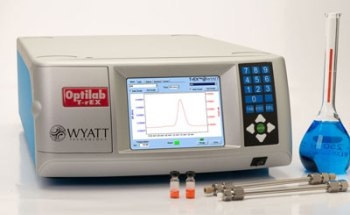
Cumulant algorithms are used in order to fit the correlation function, which is an ISO-standardized procedure. These calculations are done in real time and plotted over a logarithmic time axis. Doing this for different delay times results in the desired correlation function. Each single value of G2 is then obtained by adding together the product of two values at the same time of these two intensity traces, which is indicated by the colored connection for one position per delay time. Different delay times are marked by a different color. It shows the same intensity trace as recorded during the measurement and shifted for different delay times ꞇ. This abstract mathematical concept is visualized in Figure 3. To do this, the intensity of the scattered light at a time t is compared with the intensity of the same intensity trace shifted by the delay time ꞇ (tau). It is used to determine the translational diffusion coefficient. In fact, the correlation function is a mathematical description of the fluctuations of the scattered light. Larger particles move more slowly and therefore the decay of the correlation function is delayed. Small particles move quickly so the decay is fast. The decay represents an indirect measure of the time that the particles need to change their relative positions. The information of the size-dependent movement is included in the decay of the correlation function. This part of the correlation function is known as the baseline. If there is no similarity to the initial spot, the correlation function shows a linear behavior again. Later, you can see an exponential decay of the correlation function, which means that the particle is moving. At the beginning the correlation function is linear and almost constant, indicating that the particle is still at the same position as it was the moment before. In general, the correlation function describes how long a particle is located at the same spot within the sample. This initial intensity trace is further used to generate a correlation function (Fig. On the other hand, larger particles result in higher amplitudes between the maximum and minimum scattering intensities, as shown in Figure 2 (upper panels). Smaller particles, which are moving at higher speeds, show faster fluctuations than larger particles. The intensity of the scattered light is not constant but will fluctuate over time. The scattered light is detected over a certain time period in order to monitor the movement of the particles. Small particles do not scatter much light, which leads to an insufficient measurement signal. In contrast, the lower size limit is defined by the signal-to-noise ratio. Therefore, the onset of sedimentation indicates the upper size limit for DLS measurements. If there is sedimentation, there is no random movement, which would lead to inaccurate results. A basic requirement for the Stokes-Einstein equation is that the movement of the particles needs to be solely based on Brownian motion.

Further, the equation includes the viscosity of the dispersant and the temperature because both parameters directly influence particle movement. The speed of the particles is given by the translational diffusion coefficient D. The relation between the speed of the particles and the particle size is given by the Stokes-Einstein equation (Equation 1). If you know all other parameters which have an influence on particle movement, you can determine the hydrodynamic diameter by measuring the speed of the particles. As a result, smaller particles are moving at higher speeds than larger particles. The energy transfer is more or less constant and therefore has a greater effect on smaller particles. These collisions cause a certain amount of energy to be transferred, which induces particle movement. The principle of Brownian motion is that particles are constantly colliding with solvent molecules. When particles are dispersed in a liquid they move randomly in all directions.

Dynamic light scattering (DLS) is based on the Brownian motion of dispersed particles.


 0 kommentar(er)
0 kommentar(er)
